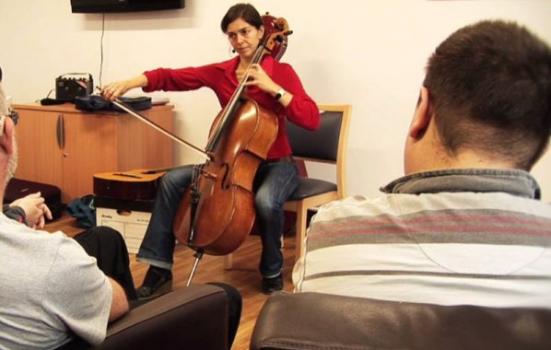From arts on prescription to recovery colleges, there are a range of ways for arts organisations to engage with public service commissioning. Jessica Harris explains exactly how each model works.

Royal Liverpool Philharmonic Orchestra
Consortia working
Consortia can range from informal collaborations and networks to legally constituted bodies. At the informal end, there may simply be a written partnership agreement as a statement of working arrangements. At the other end, some consortia have formalised arrangements through a ‘special purpose vehicle’, such as a community interest company or a social enterprise.
The managing provider model is a mid-way position, with one organisation taking on the role of prime contractor for a commission. It holds responsibility for delivery of the contract, allocates work to other consortium members and reports against agreed performance measures.
Where there is not a separate legal status outside the partners, all potential providers would have to tender as independent units to a commissioning body.
Setting up a consortium can take time and commitment from those involved, but it can also provide flexibility and scalability. By tapping into the expertise of different member organisations, it may be possible to respond to a wider range of commissions, draw in new members to expand the geographic footprint, and enable small organisations to compete with larger providers.
Liverpool Arts Regeneration Consortium operates without using a legally constituted body, whereas Without Walls is more formally organised. C3 Consortium offers a ‘hub and spoke’ model. Constituted as a membership charity for the culture and sports sectors in Suffolk and Cambridgeshire, it aims to secure funding and business development opportunities at a region-wide level.
Sub-contracting model
The sub-contracting arrangement can enable arts organisations to engage in commissioning through being sub-contracted to a main (prime) provider, such as another arts organisation or a provider of health, social care or children’s services.
For the prime provider, it benefits from the expertise that smaller organisations can bring in working with particular communities, or introducing innovative approaches
The prime provider will have a contract with the sub-contractor, covering services to be delivered and how performance will be measured, and they will hold the sub-contractor to account. Sub-contracting may also involve the use of several smaller organisations as part of a network of service providers.
Working with prime providers that sub-contract to smaller providers is of interest to many commissioners, since it means they do not have to manage multiple contracts but still receive a service tailored to specific needs.
However, systems used by some commissioners may not offer the flexibility that sub-contracting needs. Smaller organisations may be concerned about the risk of the prime provider top-slicing payments for management costs and should negotiate if these seem disproportionate. However, they will benefit from the prime provider taking on tendering, contract management and reporting tasks.
For the prime provider, it benefits from the expertise that smaller organisations can bring in working with particular communities, or introducing innovative approaches.
Kent County Council’s Community Mental Health Service has adopted this approach, as documented in our report The Art of Commissioning.
Single provider model
In the single provider model a commissioner enters into a contract with a single arts organisation. The length of the contract may vary, but due to the investment needed and the impact they have, contracts can be longer than programmes funded through grant funding.
The commissioner will normally produce a detailed specification of requirements and outcomes and will invite tenders from the market.
Sometimes commissioners use a competitive dialogue approach with a number of potential providers, with the aim of encouraging dialogue on innovative approaches to delivery. This enables commissioners to benefit from a wider perspective on the design of services, and can refine their requirements before inviting a small number of providers to tender.
As relatively small organisations, arts providers may find the process of negotiating with large contracts time-consuming and challenging
Commissioners in public health, adult social care, children’s services, clinical commissioning groups and NHS trusts may look to contract with a single provider in this way.
As relatively small organisations, arts providers may find the process of negotiating with large contracts time-consuming and challenging. They will need to show that their bid provides value for money, while ensuring all the costs of fulfilling the contract are covered.
On the other hand, where there is a good relationship with a commissioner, they may find they can have significant influence over the design and delivery of a service.
An example of the model is Royal Liverpool Philharmonic Orchestra, commissioned by Mersey Care NHS Trust.
Personal budgets or micro-commissioning
Personal budgets are intended to offer individuals choice over the support they receive. This means they can include arts activities as part of their care plan with the agreement of their social care team.
Many councils have set up framework agreements under which providers are accredited to offer services at an agreed price. Arts organisations can apply to have their services included in these agreements, and then promote themselves directly to service users.
Arts organisations may face challenges in identifying artists who are experienced in working with people with care and support needs. They may also face competition from providers outside the arts sector as they will generally require users to commit to a minimum number of sessions in order to finance a sustainable service.
Personal budgets principles are underpinned by the Care Act, which states that a diverse market is one in which people using social care and support services (and their carers) should have the choice of high-quality providers and different types of services.
Core Arts is one example of an arts organisation which delivers services funded by personal budgets.
Arts and culture on prescription
Arts and culture on prescription is a means of providing arts and cultural activities to people through a referral process. Referrals may come via GPs, other health professionals or care agencies.
In some cases, commissioning arrangements may also fund self-referrals. It is commonly focussed on people with mild to moderate depression or anxiety, and people with long-term mental health problems. Schemes frequently allow for 10 to 12 weekly sessions (although there are variations on this) and are often supported by progression into other arts or creative programmes.
Commissioners include public health teams, clinical commissioning groups, individual GPs or clusters of GP practices, health and wellbeing partnerships and NHS mental health trusts.
For arts organisations it may be difficult to attract or develop artists with experience of working with people living with mental health challenges. Establishing appropriate progression routes can also be an issue. However, many arts on prescription services work in partnership with other specialists and services to overcome these challenges.
Trestle Theatre’s pilot is an example of a scheme funded by a health and wellbeing partnership.
Recovery colleges
Recovery colleges aim to enable people with mental health issues to become experts in their own self-care and manage their own recovery journey, by helping them recognise and build on their skills and ambitions.
Recovery colleges generally commission courses from a range of providers and some, such as South London and Maudsley NHS Foundation Trust, use arts provision as part of this mix. Those who manage the programme of courses are responsible for commissioning and the participants’ choice of courses will influence the commissioners’ decisions.
Arts organisations may find that managers from a clinical background may not have considered using the arts as a means of recovery. However, co-production principles should open up opportunities for arts organisations, allowing them to propose partnership-working to develop and design courses with mental health experts and patients.
National frameworks
In a national framework model one or more organisations provide a centralised resource and carry out tasks such as developing strong relationships with national bodies that influence commissioners working at a local level, designing an outline delivery programme, and drawing together data that shows evidence of impact.
This framework allows organisations to develop relationships with commissioners at a local level, while at a national level there may be scope for the national lead organisation to secure commissions.
The model requires capacity and expertise at a national level, along with the ability to manage complexity, but it offers a coherent approach to the collation of evidence. It also lends itself to scaleability, as at the early stages there may be relatively few local partners involved, but over time this may grow as others see the opportunity.
The Reading Well Books on Prescription Scheme, developed by The Reading Agency in partnership with the Society of Chief Librarians, is an example of this model. It has enabled library services in Devon, South Gloucestershire and Warwickshire to secure commissions.
Jessica Harris is Cultural Commissioning Programme Manager at the National Council for Voluntary Organisations.
www.ncvo.org/CCProg
The Cultural Commissioning Programme is a three-year Arts Council England funded programme which supports the arts and cultural sector to engage with public service commissioning, and also works with commissioners to raise their awareness and understanding of how the arts and cultural sector can help deliver their outcomes. It is delivered by a partnership of National Council for Voluntary Organisations (lead partner), NPC and nef.
This article, sponsored and contributed by the Cultural Commissioning Programme, is in a series exploring opportunities for arts organisations, museums and library services to engage in public service commissioning.





